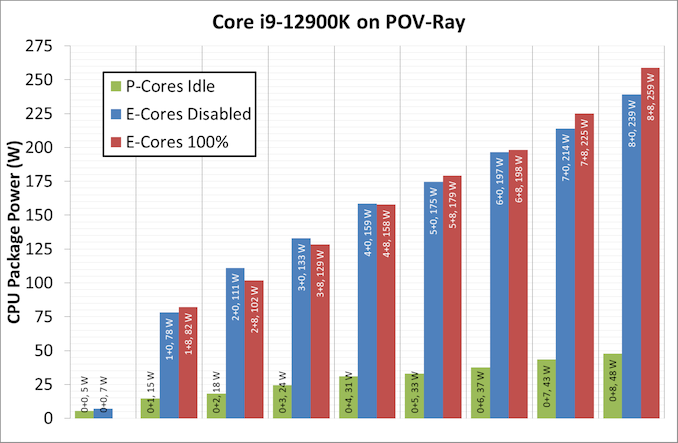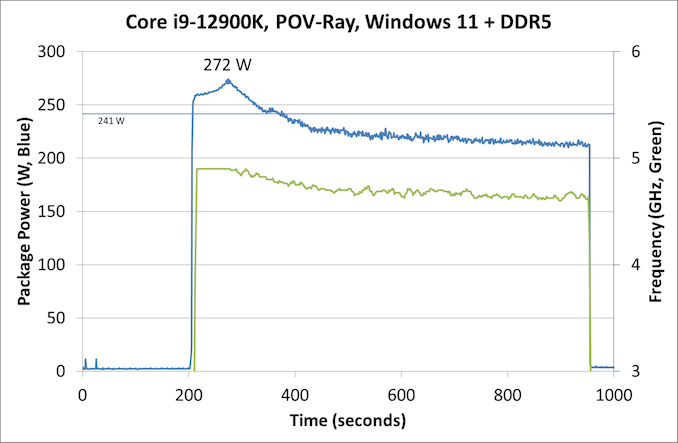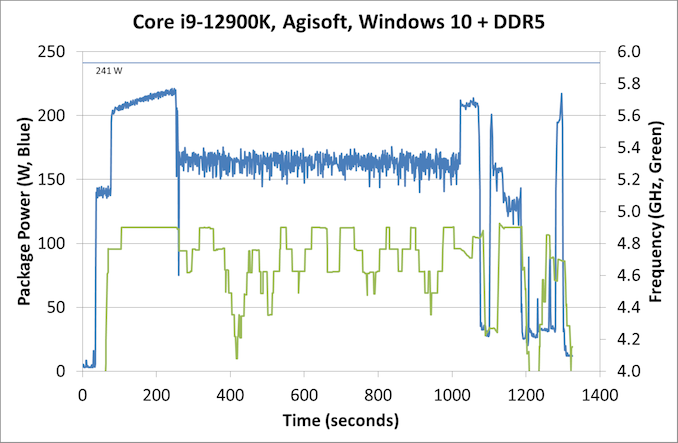The Intel 12th Gen Core i9-12900K Review: Hybrid Performance Brings Hybrid Complexity
by Dr. Ian Cutress & Andrei Frumusanu on November 4, 2021 9:00 AM ESTPower: P-Core vs E-Core, Win10 vs Win11
For Alder Lake, Intel brings two new things into the mix when we start talking about power.
First is what we’ve already talked about, the new P-core and E-core, each with different levels of performance per watt and targeted at different sorts of workloads. While the P-cores are expected to mimic previous generations of Intel processors, the E-cores should offer an interesting look into how low power operation might work on these systems and in future mobile systems.
The second element is how Intel is describing power. Rather than simply quote a ‘TDP’, or Thermal Design Power, Intel has decided (with much rejoicing) to start putting two numbers next to each processor, one for the base processor power and one for maximum turbo processor power, which we’ll call Base and Turbo. The idea is that the Base power mimics the TDP value we had before – it’s the power at which the all-core base frequency is guaranteed to. The Turbo power indicates the highest power level that should be observed in normal power virus (usually defined as something causing 90-95% of the CPU to continually switch) situation. There is usually a weighted time factor that limits how long a processor can remain in its Turbo state for slowly reeling back, but for the K processors Intel has made that time factor effectively infinite – with the right cooling, these processors should be able to use their Turbo power all day, all week, and all year.
So with that in mind, let’s start simply looking at the individual P-cores and E-cores.
Listed in red, in this test, all 8P+8E cores fully loaded (on DDR5), we get a CPU package power of 259 W. The progression from idle to load is steady, although there is a big jump from idle to single core. When one core is loaded, we go from 7 W to 78 W, which is a big 71 W jump. Because this is package power (the output for core power had some issues), this does include firing up the ring, the L3 cache, and the DRAM controller, but even if that makes 20% of the difference, we’re still looking at ~55-60 W enabled for a single core. By comparison, for our single thread SPEC power testing on Linux, we see a more modest 25-30W per core, which we put down to POV-Ray’s instruction density.
By contrast, in green, the E-cores only jump from 5 W to 15 W when a single core is active, and that is the same number as we see on SPEC power testing. Using all the E-cores, at 3.9 GHz, brings the package power up to 48 W total.
It is worth noting that there are differences between the blue bars (P-cores only) and the red bars (all cores, with E-cores loaded all the time), and that sometimes the blue bar consumes more power than the red bar. Our blue bar tests were done with E-cores disabled in the BIOS, which means that there might be more leeway in balancing a workload across a smaller number of cores, allowing for higher power. However as everything ramps up, the advantage swings the other way it seems. It’s a bit odd to see this behavior.
Moving on to individual testing, and here’s a look at a power trace of POV-Ray in Windows 11:
Here we’re seeing a higher spike in power, up to 272 W now, with the system at 4.9 GHz all-core. Interestingly enough, we see a decrease of power through the 241 W Turbo Power limit, and it settles around 225 W, with the reported frequency actually dropping to between 4.7-4.8 GHz instead. Technically this all-core is meant to take into account some of the E-cores, so this might be a case of the workload distributing itself and finding the best performance/power point when it comes to instruction mix, cache mix, and IO requirements. However, it takes a good 3-5 minutes to get there, if that’s the case.
Intrigued by this, I looked at how some of our other tests did between different operating systems. Enter Agisoft:
Between Windows 10 and Windows 11, the traces look near identical. The actual run time was 5 seconds faster on Windows 11 out of 20 minutes, so 0.4% faster, which we would consider run-to-run variation. The peaks and spikes look barely higher in Windows 11, and the frequency trace in Windows 11 looks a little more consistent, but overall they’re practically the same.
For our usual power graphs, we get something like this, and we’ll also add in the AVX-512 numbers from that page:

Compared to Intel’s previous 11th Generation Processor, the Alder Lake Core i9 uses more power during AVX2, but is actually lower in AVX-512. The difficulty of presenting this graph in the future is based on those E-cores; they're more efficient, and as you’ll see in the results later. Even on AVX-512, Alder Lake pulls out a performance lead using 50 W fewer than 11th Gen.
When we compare it to AMD however, with that 142 W PPT limit that AMD has, Intel is often trailing at a 20-70 W deficit when we’re looking at full load efficiency. That being said, Intel is likely going to argue that in mixed workloads, such as two software programs running where something is on the E-cores, it wants to be the more efficient design.














474 Comments
View All Comments
EnglishMike - Thursday, November 4, 2021 - link
Apple's CPU performance and performance/watt are impressive, but it's going to take a lot more than that to make Intel/AMD start quaking in their boots, and that's not going to happen as long as Apple remains solely a vertical integrator of premium priced computers.If anything, Apple's recent advances will only galvanize AMD and Intel's CPU designers now they can see what can be achieved, and how.
michael2k - Thursday, November 4, 2021 - link
As long as Apple monopolizes TSMC’s leading edge nodes it really doesn’t matter how much Intel tries until they can get I4 online.Right now Intel can’t beat TSMC’s N5 or N5P process and AMD can’t afford either. On the flip side that means AMD can’t afford to design a better CPU because they’re also stuck on N7 and N7P.
Ppietra - Friday, November 5, 2021 - link
people are focusing too much on nodes! Apple’s node advantage over AMD isn’t that big in terms of what efficiency you get out of it. AMD is already using the N7+ node in some of its processors, and that puts it just around 10% behind the N5 node used by the M1 Max in performance per watt.michael2k - Thursday, November 4, 2021 - link
For now. Apple has more desktops using the M1P/M1M incoming.It's astounding to consider that a 60W part is competitive at all with a 300W part:
https://www.anandtech.com/show/17047/the-intel-12t...
vs
https://www.anandtech.com/show/17024/apple-m1-max-...
Go from 8p2e to 16p4e and power only goes up to 120W and the M1 scores could double, 106 SPECint2017_r and 162 SPECfp2017_r barring complexity due to memory bus overhead, CPU bus/fabric communication overhead, etc, since it's clear that the rate-n test performs far better when paired with DDR5 vs DDR4
Ppietra - Thursday, November 4, 2021 - link
Actually the M1 Max is a 43W part at CPU peak power, not 60W (60 was for the all machine).So when Apple doubles the cores it would be closer to 85W. 170W when using 4 times the cores, which will almost certainly happen.
That would mean that Apple could easily have more than double the performance at almost half the power consumption.
roknonce - Thursday, November 4, 2021 - link
It's not true that 12900k must use 300w, in fact, they can get over 90% performance with 150w. If you set voltage manually, you can get a P-core @ 3.2Ghz + E-core @2.4Ghz within 35w (Source: GeekerWan). Its Cinebench R23 score is ST1350, MT14k. What about M1 Max? ST 1500, Mt 12k. In addition, TSMC N5p is 30% better than 10nm ESF. Consider again if a 60W part is competitive at all with a 300W part?roknonce - Friday, November 5, 2021 - link
Edit: It's 6*P-core @ 3.2Ghz + 8*E-core @2.4Ghz within 35w to roughly simulate a H35/H45 mobile chip.Ppietra - Friday, November 5, 2021 - link
The thing with Cinebench is that it takes a lot of advantage from hyperthreading, which is good of course when you have it, something that the M1 doesn’t have.The problem is, because of this and many other differences between CPUs, Cinebench is only a good benchmark to compare to the M1 in a small set of tasks. Not exactly a general definition of competition.
As for power consumption, consider that the M1 Max CPU has a peak power of 43W, while other high end Laptop CPUs have a typical peak power at around 75-80W, even if they say 45W TDP.
roknonce - Sunday, November 7, 2021 - link
I'm literally saying peak power during the test. 6*P-core @0.75v, not the BS TDP, my friend. I totally agree that Cinebench cannot tell everything. But consider the enormous gap between N5P and 10nm ESF. The result is reasonable and for intel fans, is good enough to call it inspiring.charlesg - Thursday, November 4, 2021 - link
I think there's an error in the AVX2 Peak Power graph on the last page? I think one of the two 5900s listed is supposed to be 5950?